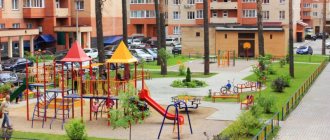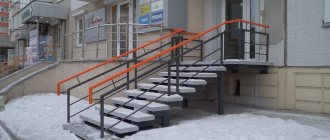Perhaps you have at least once thought that the ceiling of your apartment is the floor of the neighbors above. This raises the question: whose property is this?
The real estate portal superrielt.ru found out from Andrey Pinchukov, head of the Interregional Commission for Monitoring the Enforcement of Property Rights of Owners of Apartment Buildings in the Subjects and Municipal Entities of the Russian Federation, NP Housing and Communal Services Control, where in reality the boundaries of the apartment lie and what begins behind them.
How to find out where is your apartment and where is the common property?
Common property begins right outside the apartment door. Even if you have a vestibule for several apartments in front of the landing, it is still considered the common property of the residents.
The owner of the apartment does not have any preemptive right to the space that begins behind the door of his apartment. Of course, every person strives to occupy additional space (equip a closet, a shoe rack or a door), and this can be done, but only after an appropriate vote at a general meeting of premises owners, and then agreeing on the decision with the management company or homeowners association. This must be done so as not to violate sanitary and fire safety rules.
Housing and communal services news
The adjacent territory is included in the common property of an apartment building if the land plot is registered in the cadastral register. In this article we will consider the responsibility of the management organization beyond the boundaries of the local area.
Logically, and by law, the management organization (MA) is only obliged to carry out mandatory work only within the local area, which is classified as common property (CP) of the apartment building by virtue of Art. 36 of the Housing Code of the Russian Federation (hereinafter referred to as the Housing Code of the Russian Federation), paragraph 2 of the Rules for the maintenance of common property of apartment buildings, which were approved by Decree of the Government of the Russian Federation No. 491 of August 13, 2006 (hereinafter referred to as Rules 491).
Subparagraph “e” of paragraph 2 of Rules 491 states that the UI MKD includes, among other things, the land plot on which the apartment building is located, and the boundaries of which are determined on the basis of state cadastral registration data, with elements of landscaping and landscaping.
In subparagraph 4 of paragraph 1 of Art. 36 of the Housing Code of the Russian Federation establishes that the land plot on which this house is located, with elements of landscaping and improvement, and other objects intended for the maintenance, operation and improvement of this house and located on the specified land plot, also belongs to the OI MKD. The boundaries and size of the land plot on which the apartment building is located are determined in accordance with the requirements of land legislation and legislation on urban planning.
Thus, only the formed land plot, which was registered with the state cadastral register, is included in the common property. This procedure is determined by Article 16 of Federal Law No. 189-FZ of December 29, 2004 (hereinafter referred to as Law No. 189-FZ).
In this article we will analyze the practice of courts on this topic. How and in what way judicial practice develops on the issue of assigning responsibility to the management organization for the maintenance of both the local area and beyond its borders.
Decision of the Arbitration Court of the Sverdlovsk Region dated July 18, 2021 in case No. A60-10108/2016. Inspection of container sites outside the local area by municipal control. For each site, a fine of 25,000 rubles was famously imposed. For one even 2 times - 2 days in a row we were not lazy to go and watch it. The court considered all container sites to be the common property of the apartment building, without going into details. The UO, apparently, did not oppose this statement either, or this was not reflected in the court decision. As a result, the court canceled only the double fine for the same violation.
The location of one of the sites outside the local area did not serve as a reason for exemption from the fine, nor did the fact that the garbage collection organization did not remove the garbage on time and in violation of the schedule:
“... The applicant’s arguments about the absence of an obligation to clean the territory adjacent to the container site are rejected by the court, due to the fact that ensuring cleanliness at the waste accumulation site and the adjacent territory is the responsibility of the company, directly provided for by law. The location of a container site outside the land plot assigned to an apartment building does not relieve the applicant from the obligation to maintain cleanliness in the area adjacent to it.
...The applicant’s reference to the existence of contracts under which the provision of services for the removal of solid waste and civil waste is carried out is untenable. Removal of waste from the container site in accordance with the schedule does not indicate proper maintenance of cleanliness in the area adjacent to it. In addition, the company is not charged with violating the organization of waste removal and monitoring the implementation of the waste disposal schedule.”
Resolution of the Central District Court of February 11, 2021 in case No. A62-2194/2018: in this case, the traffic police issued an order to the management organization that it must organize the elimination of winter slipperiness and snow removal of the sidewalk and road in the courtyard area. It is not enough for the management organizations of municipal, housing and licensing control, and the traffic police also contribute to issuing “strange” orders.
The first instance canceled the order partially, the appeal canceled it in full. The Cassation Court agreed with the appeal:
“...Cancelling the court decision and recognizing the contested order as invalid in full, the appellate court motivated its conclusion by the fact that the company is not a person obliged to maintain highways and be responsible for road safety, and the Ministry of Internal Affairs is not a person authorized to carry out inspections in relation to compliance by management organizations with the rules for maintaining local areas and issue orders for failure to properly care for these areas.”
This decision reminded me of a case from the practice of working in a management organization, when the traffic police sent a letter to us saying that it was necessary to remove a huge shaft of snow near a house served by the management authority. They also threatened with a fine and liability for failure to comply with the traffic police’s request for data on the driver of the contractor’s tractor serving our organization. When they started to find out what kind of snow bank it was, it turned out that its “author” was an organization hired by the traffic police, and the snow was cleared from the very territory of the regional traffic police, which was right next to our house.
Appeal ruling of the Supreme Court of the Republic of Karelia dated March 22, 2019 No. 33-1105/2019. This matter is a little off topic of the article, since the UO was punished for a slippery sidewalk in the local area. But it reflects the message of our courts: the MA is always at fault, once there is a claim, there is no “exculpatory” decision for the MA. The fallen woman wanted 1,000,000 rubles from the administrative authority for moral damages due to a fall on a slippery sidewalk. It is clear that the health of every person is priceless, but the essence of the matter here is generally interesting. The examination established that her injuries were old and were not caused by a fall at the time she indicated (!), and the deterioration of her condition cannot be regarded as causing harm. But our fairest court in the world still collected 4 thousand rubles. moral damage and 2 thousand rubles. fine from the management organization. The second instance agreed with this decision.
Resolution of the Presidium of the Omsk Regional Court dated September 24, 2018 in case No. 44G-80/2018. The owner of the car filed a lawsuit against the UO and the Federal State Unitary Enterprise of the Ministry of Defense for compensation for losses caused by a fallen tree. He was not the owner of the apartment building under the management of the management company. The first instance recovered damages from the Ministry of Defense, the second - from the management organization. The cassation sent the case for a new consideration, since the land plot of the local area has not been formed, so the management authority has no obligation to care for the plantings. In addition, the land plot on which the tree grew generally belongs to the Ministry of Defense, as indicated in the case materials. How and on what basis the appellate court made a decision in the case is unclear. Probably, the “inner conviction” of the judges prompted such a decision. By the way, the appeal considered the Landscaping Rules to be a more significant regulatory legal act than the federal norms of the law.
Appeal ruling of the Irkutsk Regional Court dated November 22, 2021 in case No. 33-9802/2017. The case is also very interesting. And it speaks of a clear gap among some judges in their knowledge of housing legislation. A child injured himself on the playground. The lawsuit was filed by the prosecutor against the city administration. The court of first instance rejected the claim. In his complaint, the prosecutor now considered that the court incorrectly determined the ownership of the playground and the UO should be held accountable. Either the ruling did not indicate the involvement of the UO as a co-defendant, or the court immediately forgot to indicate the second defendant in the introductory part. But in the ruling of the appellate court, the second defendant in the form of the UO appears out of nowhere, like that genie from a fairy tale... But that’s not the point.
The appeal based its decision on the same rules of landscaping and the technical passport of the house, which indicated the size of the local area as 24 meters from the wall of the house. And the accident with the child happened at 28 meters, where there was a playground. By the way, the area of the adjacent territory has not been formed and is not registered in the cadastral register, just as the judicial act did not establish that the playground belongs to the common property of the apartment building. But the court still recovered from the administration the damage caused to the child’s health, although it was guided by strange judgments and norms. And not a single norm of the Housing Code of the Russian Federation or other housing legislation in the judicial act!
Appeal ruling of the Omsk Regional Court dated October 25, 2018 in case No. 33-6815/2018. This case can also be classified as a judicial act with strange conclusions, the sophistication of which can be envied. A claim for damage caused to a car by a fallen tree was brought against the administration and management organization. Although the land plot of the local area was not formed, the courts of two instances considered the UO to be at fault and collected more than 200 thousand rubles in damages from it (who would doubt a fair court in the Russian Federation!). The court made the following conclusions:
“...Having examined the photographic material presented in the case (volume 1, pp. 128 - 131), extracted from the electronic map, the court came to the conclusion that the plaintiff’s car at the time the tree fell on it was in the area of the land plot belonging to adjacent territory of an apartment building located at the address: Omsk, <...>, while the boundaries and size of the land plot on which the apartment building is located are not defined, and therefore the maintenance of the adjacent territory is carried out within the actual serviced territory, with taking into account the location of landscaping, landscaping, and infrastructure facilities related to the apartment building.
According to the public cadastral map of the Omsk region, the land plot on which the fallen tree grew is territory owned by the municipality of Omsk.
...In Art. 104 “Rules for improvement, ensuring cleanliness and order in the territory of the city of Omsk”, approved. By decision of the Omsk City Council dated July 25, 2007 No. 45, the obligation of persons carrying out activities for the maintenance of common property in an apartment building is fixed for the maintenance and cleaning of land plots, the boundaries and size of which are determined in accordance with the requirements of land legislation and legislation on urban planning activities, owned by on the right of common shared ownership to the owners of premises in an apartment building, including pedestrian paths, sidewalks, entrances (exits) to courtyards, parking lots, children's, sports and other playgrounds, landscaping elements, and small architectural forms located on such areas.
If the boundaries and size of the land plots on which apartment buildings are located are not defined, persons engaged in the maintenance of common property in an apartment building are charged with maintaining and cleaning the adjacent areas, the size of which is determined by the owners of premises in apartment buildings on the common meeting of owners of premises in apartment buildings, held in accordance with the requirements of Article 45 of the Housing Code of the Russian Federation, taking into account the following features:
Until the boundaries of the local area are determined for maintenance and cleaning, the obligation to maintain and clean the adjacent areas, including landscaping elements located in such areas, pedestrian paths, sidewalks, entrances (exits) to courtyards, children's, sports and other playgrounds, small architectural forms , other facilities intended for the maintenance, operation and improvement of this apartment building, is assigned to persons carrying out activities for the maintenance of common property in the apartment building, within the following limits:
- a five-meter area adjacent to the perimeter of apartment buildings with from 1 to 4 floors inclusive;
- a ten-meter area adjacent to the perimeter of apartment buildings with 5 or more floors;
- the territory adjacent to the perimeter of apartment buildings, to the boundaries of territories, the maintenance and cleaning responsibilities of which are assigned to other business entities, if the distance from the apartment building to these territories is less than the distance specified in paragraphs 1, 2 of this part;
- the entire area of the adjacent territory with the specified improvement elements located on them in the event that the areas of the adjacent territories extend beyond the boundaries of the adjacent territories specified in paragraphs 1 and 2 of this part, and the territory is actually used by the owners of this apartment building.
...Contrary to the appellant’s arguments about the validity of the above norm in time, the judicial panel considers it possible to agree with the conclusion of the district court regarding the method of determining the land plot related to the service perimeter of the disputed apartment building by the management company (!!!).
In particular, the plaintiff’s side, with reference to the photographs reviewed by the appellate court, explained that the parking lot where the damaged car was located is a specially equipped pocket located directly in front of the entrances of the apartment building, and is used exclusively for parking by its residents. The fallen tree is located on the adjacent plot of land parallel to infrastructure such as a children's playground, directly in front of the first entrance of their house. The above-mentioned site, parking lot, and playground are maintained by the management company, which is also evidenced by the appeal of ZhKO Vysotny LLC to the competent authorities regarding the issue of crowning a fallen tree.
It also follows from the public cadastral map that the land plot adjacent to house No. <...> by <...> does not belong to nearby residential buildings; it is directly used by the resident of the above house.
The fact that the scheme for cleaning the adjacent territory of a multi-storey apartment building located at the address: <...> does not reflect the actual land plot being serviced does not relieve the management company of responsibility for damage caused by improper provision of services.
...The above indicates that the area of the local area of the house at the address: <...> actually extends beyond the ten-meter territory adjacent to the perimeter of the specified apartment building, despite the fact that the boundaries and size of the land plot on which the specified apartment building is located are not defined in in the prescribed manner.
Based on the current legislation, the management company provides citizens living in an apartment building with services for the proper maintenance of housing and routine repairs of the common property of the apartment building, therefore, it is responsible for the care of green spaces, due to which the condition of the green spaces related to the common property of the house plantings, the fall of which caused damage to the plaintiff’s property, indicates inadequate quality of service provision.”
Based on materials from the blog Burmistr.ru https://www.burmistr.ru, article by Ilmira Nosik.
Is the outer wall of the house part of your apartment?
To install an air conditioner or an advertising structure on a load-bearing wall, or to glaze a loggia or balcony, a decision of the general meeting of owners of apartments and premises (for example, attached to a store or pharmacy building) in the house is required.
For other issues regarding the use of external walls and balcony railings, rules adopted at the general meeting are required. At the same time, the established rules should not conflict with the established municipal authorities.
In addition, at the general meeting it is necessary to discuss at least once the issue of placing advertising structures and establish rules for concluding contracts for the installation of advertising structures and posters (including the cost of such a service and the purpose of spending the proceeds), entrusting this, for example, to the house council, the chairman of the council and management company.
It is important to remember: just because a property belongs to all residents, does not mean that any of its elements can be used for personal purposes. For example, by fencing off a parking space for his car, a resident of the house violates the rights of other owners, if he does not have the right that was agreed upon at the general meeting. Regarding all these issues, more than 50% of the votes of the owners of the premises in the house are sufficient to make a decision.
The boundaries of the division of balance sheet and operational liability are different Law Firm Vershina
The balance holder of the electrical network is a legal or private entity that consumes electricity through the connected electrical network, that is, an electricity consumer (subscriber). The balance holder of the electrical network operates the electrical network assigned to him at his own expense.
The act of balance sheet ownership and operational responsibility of the parties is a document that defines the boundaries of balance sheet ownership between the energy supply organization and legal entities or individuals. The act of delimiting the balance sheet ownership of the electrical network is drawn up in the process of technological connection of power receiving devices (electrical installations).
An energy supply organization is a commercial organization, regardless of its legal form, that sells produced or purchased electrical energy to subscribers.
Important
At the same time, the boundary of operational responsibility presupposes a dividing line based on the burden of maintaining the relevant utilities and generally runs along the line of balance sheet ownership, however, the parties to the contract can also agree on a different boundary of operational responsibility. Composition of the common property of premises owners in apartment buildings.
Division of operational responsibilities between the parties
More details about the procedure for organizing work on issuing permits for admission to operation of power plants can be found in the article “Procedure for organizing work for issuing permits for admission to operation of power plants.”
Operational responsibility: where are the boundaries?
Gas supply is considered to be the fulfillment by the gas supplier of obligations arising from the contract, expressed in the performance of a set of actions ensuring the supply of natural gas through the gas distribution network or liquefied hydrocarbon gas from a tank or group cylinder installation to the boundary of the division of ownership of gas distribution (connected) networks, determined in the prescribed manner . In turn, in-house gas equipment includes gas pipelines of an apartment building (ABC) or a residential building connected to a gas distribution network or a tank (group) cylinder installation, providing gas supply to the connection point of gas-using equipment, as well as gas-using equipment and gas metering devices.
Attention
According to the Law on Heat Supply, commercial metering of heat energy and coolant is carried out by measuring them with metering devices that are installed at the metering point located on the border of the balance sheet, unless another metering point is specified by the heat supply agreement or the contract for the provision of services for the transfer of thermal energy. The point of metering of thermal energy and coolant is a place in the heat supply system in which, using metering devices or by calculation, the quantity and quality of produced, transmitted or consumed thermal energy and coolant are established for the purposes of commercial accounting (clause
24 Art. 2 of the Heat Supply Law). Concepts in the field of gas supply are somewhat different from those given above. They are set out in clause 3 of the Rules for the supply of gas to meet the household needs of citizens, approved by Decree of the Government of the Russian Federation of July 21, 2008 No. 549.
Meters must be located in dry rooms that are easily accessible for maintenance, in a place that is sufficiently free and not cramped for work with a temperature in winter not lower than 0 ° C. General industrial meters are not allowed to be installed in rooms where, due to production conditions, the temperature can often exceed +40 °C, as well as in rooms with aggressive environments.
It is allowed to place meters in unheated rooms and corridors of switchgears of power plants and substations, as well as in outdoor cabinets.
In this case, provision should be made for their stationary insulation for the winter through insulating cabinets, hoods with heating of the air inside them with an electric lamp or heating element to ensure a positive temperature inside the hood, but not higher than +20 ° C.
Which wires are yours and which are common?
Communications (wires and pipes) can be divided into three parts, with different entities responsible for maintaining each.
The owner, the management company, and the resource supply organization (RSO) are simultaneously responsible for the supply of utility resources. Accordingly, if there are problems on utility networks, each of them has its own area of responsibility.
As for electricity, the management company is responsible exactly to the point where an individual electrical energy meter is installed - that is, a meter. It and the wires that go further into the apartment are considered the property of the residents. In the absence of a meter, the boundary passes through the connecting terminals of the circuit breakers in the panel.
From the street side, the common house power supply system ends where the common house meter connects to the electrical network that enters the house. In the absence of a meter, the boundary is the external wall of the building, unless otherwise provided in the agreement on the division of responsibility concluded between the RSO and the management company. The basic rule here is that networks and equipment that provide resources to a specific home are in common ownership.
Is the owner responsible for the plumbing?
Residents are responsible for part of the cold and hot water supply, starting from the valve. It includes a meter, shut-off valves, and pipes that lead to the taps. In the absence of valves, it is usually assumed that the occupants are responsible for the part of the system that begins at the location of the first outlets from the risers.
From the street side, the common house cold and hot water supply system begins from the place where the pipeline entering the building connects to the common house meter. And in the absence of a meter - by the outside of the house, unless the agreement on the division of responsibilities concluded between the RSO and the management company states otherwise.
Contents of acts of delimitation and responsibility
Completing the document correctly is very important.
If even one mistake is made, the paper cannot be recognized as valid, which means it will have no power. But if you are not a professional lawyer, then do not worry, because the form of this document is quite simple. You don’t even have to download the form, but fill out the paper yourself in simple written form. Both sample documents must contain the following information:
- Personal information about the parties to the transaction:
- Name of enterprises;
- Full names of representatives of these companies;
- Passport information of citizens.
- A list of points of different water supply and sanitation systems, as well as points of connection of technical equipment that tracks the amount of resources spent;
- An accurate and complete description of the powers vested in each party.
- A schematic description of all communications that become partly owned by the second party;
- Other information necessary to clarify other nuances regarding certain circumstances. Also, this paragraph specifies other circumstances of the transaction that reveal the circumstances of the powers granted.
Download: Act of delimitation of balance sheet ownership and operational responsibility of water supply and sanitation networks
How is responsibility distributed in the heating system?
In heating systems, as in others, there are different areas of responsibility. For example, if the radiators that are located in the apartment have disconnecting devices (valves) located on branches from the risers of the intra-house network, then the battery is not considered part of the common property, and the owner of the apartment must repair and replace it. If there is no valve, the management company is obliged to eliminate leaks and, if necessary, replace the radiator. Such radiators are considered part of the heating system, since their performance affects the supply of resources to more than one apartment.
As for the street side, the management company is responsible for the area, starting from the place where the pipeline entering the house connects to the general building meter, and in the absence of a meter, starting from the outside of the house, if in the agreement on the division of responsibility concluded between the RSO and the management company, not otherwise provided.
Is the owner responsible for sewerage?
Most of the drainage system is considered common property, and RSOs are responsible for it. The owner is responsible for the site that ends with the first tee of the transit riser (that is, the first branch from the riser). Next comes the area of responsibility of the management company.
RSOs are responsible for the networks that begin from the point where sewer outlets enter the first inspection well.
If utility networks run under the house in the land that is the property of the residents and in the basement of the house, this does not mean that the communications belong to the residents.
The current legislation does not always say exactly where the area of responsibility of the RSO and the management company begins, therefore the distribution of responsibility and the establishment of boundaries for each specific house is stipulated in a separate agreement.









